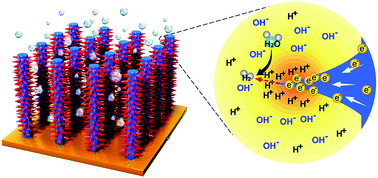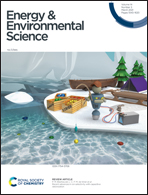Proton selective adsorption on Pt–Ni nano-thorn array electrodes for superior hydrogen evolution activity†
Abstract
Conventional acidic water electrolysis for large-scale hydrogen production needs to involve a noble metal catalyst for the anode to resist electrochemical oxidation, while alkaline electrolysis can provide better anode protection, but hydrogen ions become a minority species, which leads to sluggish hydrogen evolution reaction (HER) kinetics. Herein, by developing a unique nano-thorn-like Pt–Ni nanowire electrode as a superior HER catalyst, we enable a local “pseudo-acidic” environment near the cathode surface in an alkaline electrolyzer. In such a situation, we observed dramatic enhancement of selective H+ adsorption versus K+, leading to an extremely high HER performance towards real applications, with low overpotentials (ηgeo-surface area) of 23 mV and 71 mV at current densities of 10 mA cm−2 and 200 mA cm−2, respectively. This result is exceptionally better than the state-of-the-art Pt-based catalysts in an alkaline electrolyte at large current densities (≥200 mA cm−2). The simulation result suggests that a strong local electric field around a nano-thorn structure can exponentially increase the diffusion rate of H+ towards the electrode surface as compared with K+, which promotes faster mass transfer and reaction kinetics for the HER in an alkaline medium.



 Please wait while we load your content...
Please wait while we load your content...